2015 NISSAN GT-R seats
[x] Cancel search: seatsPage 86 of 358
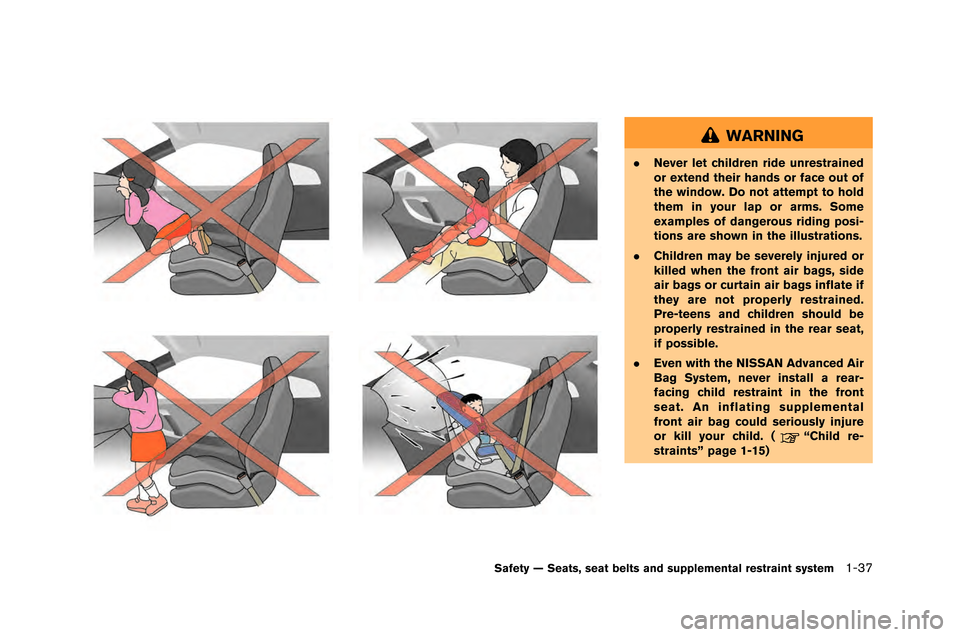
WARNING
.Never let children ride unrestrained
or extend their hands or face out of
the window. Do not attempt to hold
them in your lap or arms. Some
examples of dangerous riding posi-
tions are shown in the illustrations.
. Children may be severely injured or
killed when the front air bags, side
air bags or curtain air bags inflate if
they are not properly restrained.
Pre-teens and children should be
properly restrained in the rear seat,
if possible.
. Even with the NISSAN Advanced Air
Bag System, never install a rear-
facing child restraint in the front
seat. An inflating supplemental
front air bag could seriously injure
or kill your child. (
“Child re-
straints” page 1-15)
Safety — Seats, seat belts and supplemental restraint system1-37
Page 87 of 358
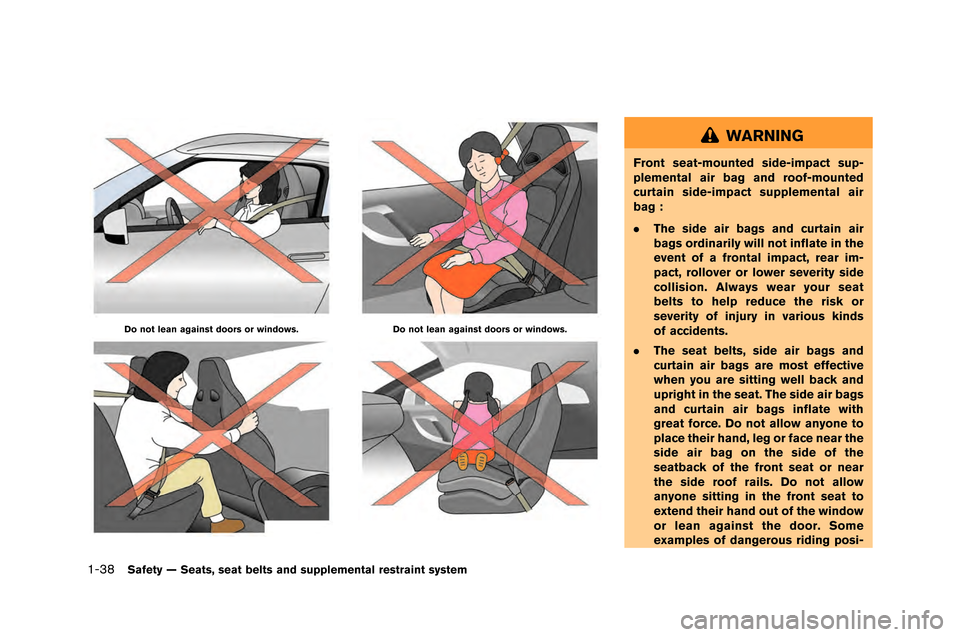
1-38Safety — Seats, seat belts and supplemental restraint system
Do not lean against doors or windows.Do not lean against doors or windows.
WARNING
Front seat-mounted side-impact sup-
plemental air bag and roof-mounted
curtain side-impact supplemental air
bag :
.The side air bags and curtain air
bags ordinarily will not inflate in the
event of a frontal impact, rear im-
pact, rollover or lower severity side
collision. Always wear your seat
belts to help reduce the risk or
severity of injury in various kinds
of accidents.
. The seat belts, side air bags and
curtain air bags are most effective
when you are sitting well back and
upright in the seat. The side air bags
and curtain air bags inflate with
great force. Do not allow anyone to
place their hand, leg or face near the
side air bag on the side of the
seatback of the front seat or near
the side roof rails. Do not allow
anyone sitting in the front seat to
extend their hand out of the window
or lean against the door. Some
examples of dangerous riding posi-
Page 88 of 358
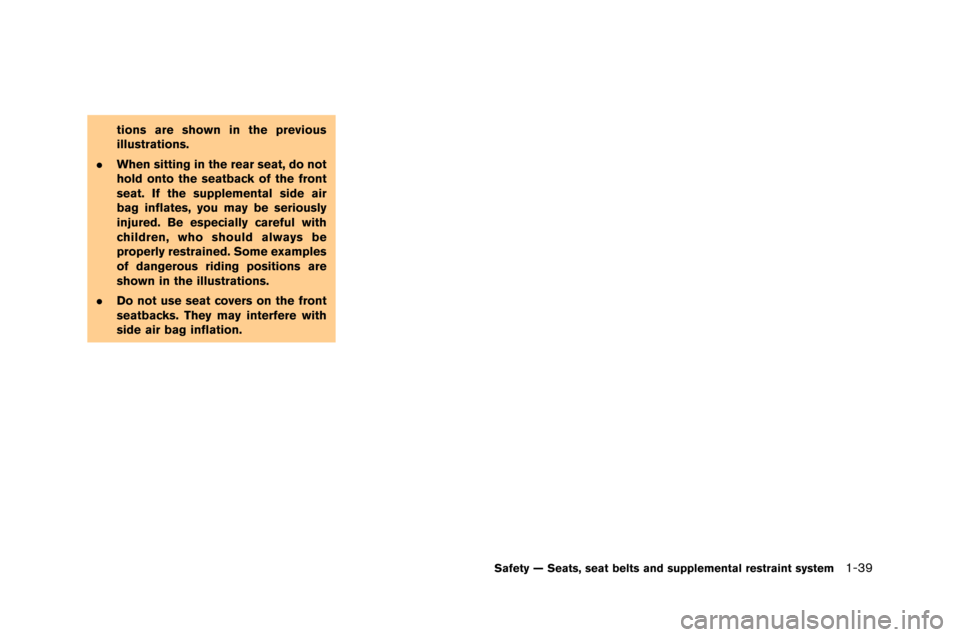
tions are shown in the previous
illustrations.
. When sitting in the rear seat, do not
hold onto the seatback of the front
seat. If the supplemental side air
bag inflates, you may be seriously
injured. Be especially careful with
children, who should always be
properly restrained. Some examples
of dangerous riding positions are
shown in the illustrations.
. Do not use seat covers on the front
seatbacks. They may interfere with
side air bag inflation.
Safety — Seats, seat belts and supplemental restraint system1-39
Page 89 of 358

1-40Safety — Seats, seat belts and supplemental restraint system
1. Crash zone sensor
2. Supple�fental front-i�fpa�bt air bag �fodules(NISSAN Advan�bed Air Bag Syste�f)
3. Front seat-�founted side-i�fpa�bt supple�fental air bags
4. Roof-�founted �burtain side-i�fpa�bt supple�fental air bags 5. Roof-�founted �burtain side-i�fpa�bt supple�fental
air bag inflators
6. Door satellite sensors
7. O�b�bupant �blassifi�bation sensor (pattern sensor)
8. O�b�bupant �blassifi�bation syste�f �bontrol unit
9. Satellite sensors 10. Seat belt pretensioners
11. Air bag Control Unit (ACU)
NISSAN ADVANCED AIR BAG SYS-
TEM (front seats)
This vehi�ble is equipped with the NISSAN
Advan�bed Air Bag Syste�f for the driver and
front passenger seats. This syste�f is designed
to �feet �bertifi�bation require�fents under U.S.
regulations. It is also per�fitted in Canada.
All of
the information, cautions and warnings in
this manual apply and must be followed.
The driver supple�fental front-i�fpa�bt air bag is
lo�bated in the �benter of the steering wheel. The
front passenger supple�fental front-i�fpa�bt air
bag is �founted in the instru�fent panel above
the glove box. The front air bags are designed to
inflate in higher severity frontal �bollisions,
although they �fay inflate if the for�bes in another
type of �bollision are si�filar to those of a higher
severity frontal i�fpa�bt. They �fay not inflate in
�bertain frontal �bollisions. Vehi�ble da�fage (or la�bk
of it) is not always an indi�bation of proper front
air bag operation.
The NISSAN Advan�bed Air Bag Syste�f has
dual stage air bag inflators. The syste�f �fonitors
infor�fation fro�f the Air bag Control Unit (ACU) ,
seat belt bu�bkle sensors and the o�b�bupant
�blassifi�bation sensor (pattern sensor) . Inflator
operation is based on the severity of a �bollision
Page 90 of 358
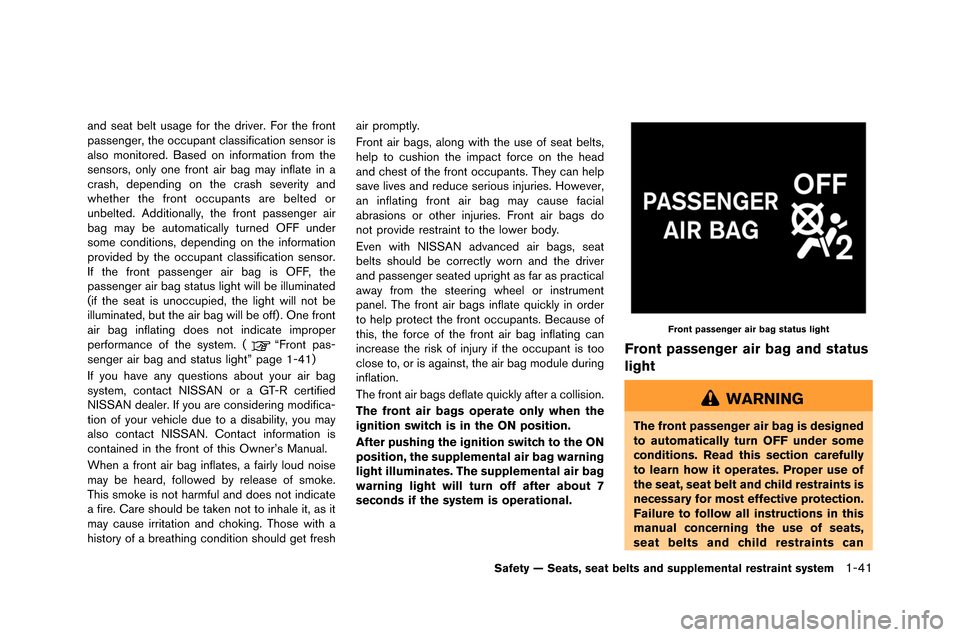
and seat belt usage for the driver. For the front
passenger�f the occupant classification sensor is
also monitored. Based on information from the
sensors�f onl�b one front air bag ma�b inflate in a
crash�f depending on the crash severit�b and
whether the front occupants are belted or
unbelted. Additionall�b�f the front passenger air
bag ma�b be automaticall�b turned OFF under
some conditions�f depending on the information
provided b�b the occupant classification sensor.
If the front passenger air bag is OFF�f the
passenger air bag status light will be illuminated
(if the seat is unoccupied�f the light will not be
illuminated�f but the air bag will be off) . One front
air bag inflating does not indicate improper
performance of the s�bstem. (
“Front pas-
senger air bag and status light” page 1-41)
If �bou have an�b questions about �bour air bag
s�bstem�f contact NISSAN or a GT-R certified
NISSAN dealer. If �bou are considering modifica-
tion of �bour vehicle due to a disabilit�b�f �bou ma�b
also contact NISSAN. Contact information is
contained in the front of this Owner’s Manual.
When a front air bag inflates�f a fairl�b loud noise
ma�b be heard�f followed b�b release of smoke.
This smoke is not harmful and does not indicate
a fire. Care should be taken not to inhale it�f as it
ma�b cause irritation and choking. Those with a
histor�b of a breathing condition should get fresh air promptl�b.
Front air bags�f along with the use of seat belts�f
help to cushion the impact force on the head
and chest of the front occupants. The�b can help
save lives and reduce serious injuries. However�f
an inflating front air bag ma�b cause facial
abrasions or other injuries. Front air bags do
not provide restraint to the lower bod�b.
Even with NISSAN advanced air bags�f seat
belts should be correctl�b worn and the driver
and passenger seated upright as far as practical
awa�b from the steering wheel or instrument
panel. The front air bags inflate quickl�b in order
to help protect the front occupants. Because of
this�f the force of the front air bag inflating can
increase the risk of injur�b if the occupant is too
close to�f or is against�f the air bag module during
inflation.
The front air bags deflate quickl�b after a collision.
The front air bags operate only when the
ignition switch is in the ON position.
After pushing the ignition switch to the ON
position, the supplemental air bag warning
light illuminates. The supplemental air bag
warning light will turn off after about 7
seconds if the system is operational.
Front passenger air bag status light
Front passenger air bag and status
light
WARNING
The front passenger air bag is designed
to automatically turn OFF under some
conditions. Read this section carefully
to learn how it operates. Proper use of
the seat, seat belt and child restraints is
necessary for most effective protection.
Failure to follow all instructions in this
manual concerning the use of seats,
seat belts and child restraints can
Safety — Seats, seat belts and supplemental restraint system1-41
Page 91 of 358
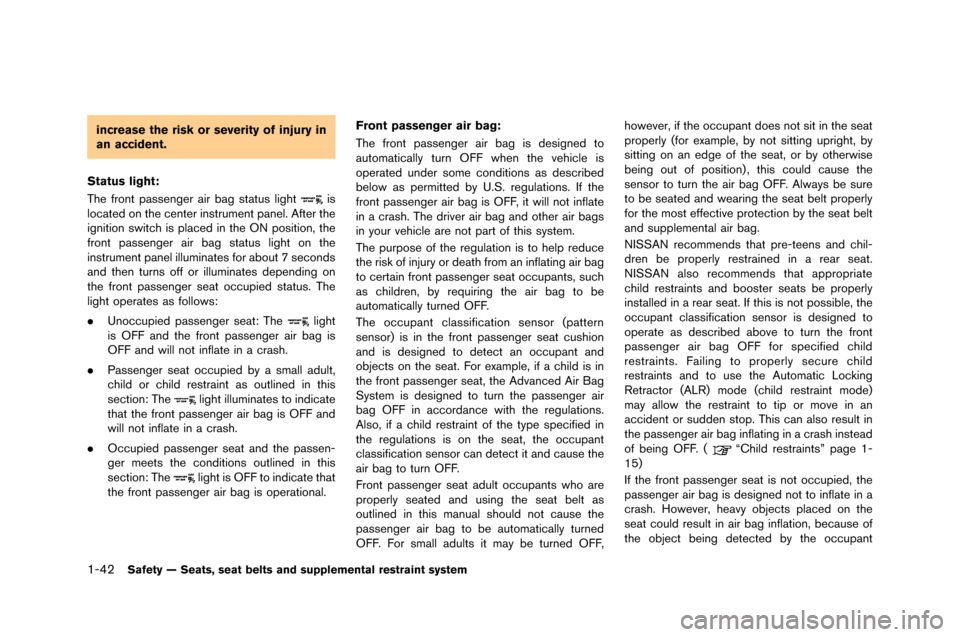
1-42Safety — Seats, seat belts and supplemental restraint system
increase the risk or severity of injury in
an accident.
Status light:
The front passenger air bag status �fight
is
�focated on the center instrument pane�f�b After the
ignition switch is p�faced in the ON position, the
front passenger air bag status �fight on the
instrument pane�f i�f�fuminates for about 7 seconds
and then turns off or i�f�fuminates depending on
the front passenger seat occupied status�b The
�fight operates as fo�f�fows:
. Unoccupied passenger seat: The
�fight
is OFF and the front passenger air bag is
OFF and wi�f�f not inf�fate in a crash�b
. Passenger seat occupied by a sma�f�f adu�ft,
chi�fd or chi�fd restraint as out�fined in this
section: The
�fight i�f�fuminates to indicate
that the front passenger air bag is OFF and
wi�f�f not inf�fate in a crash�b
. Occupied passenger seat and the passen-
ger meets the conditions out�fined in this
section: The
�fight is OFF to indicate that
the front passenger air bag is operationa�f�b Front passenger air bag:
The front passenger air bag is designed to
automatica�f�fy turn OFF when the vehic�fe is
operated under some conditions as described
be�fow as permitted by U�bS�b regu�fations�b If the
front passenger air bag is OFF, it wi�f�f not inf�fate
in a crash�b The driver air bag and other air bags
in your vehic�fe are not part of this system�b
The purpose of the regu�fation is to he�fp reduce
the risk of injury or death from an inf�fating air bag
to certain front passenger seat occupants, such
as chi�fdren, by requiring the air bag to be
automatica�f�fy turned OFF�b
The occupant c�fassification sensor (pattern
sensor) is in the front passenger seat cushion
and is designed to detect an occupant and
objects on the seat�b For examp�fe, if a chi�fd is in
the front passenger seat, the Advanced Air Bag
System is designed to turn the passenger air
bag OFF in accordance with the regu�fations�b
A�fso, if a chi�fd restraint of the type specified in
the regu�fations is on the seat, the occupant
c�fassification sensor can detect it and cause the
air bag to turn OFF�b
Front passenger seat adu�ft occupants who are
proper�fy seated and using the seat be�ft as
out�fined in this manua�f shou�fd not cause the
passenger air bag to be automatica�f�fy turned
OFF�b For sma�f�f adu�fts it may be turned OFF, however, if the occupant does not sit in the seat
proper�fy (for examp�fe, by not sitting upright, by
sitting on an edge of the seat, or by otherwise
being out of position) , this cou�fd cause the
sensor to turn the air bag OFF�b A�fways be sure
to be seated and wearing the seat be�ft proper�fy
for the most effective protection by the seat be�ft
and supp�fementa�f air bag�b
NISSAN recommends that pre-teens and chi�f-
dren be proper�fy restrained in a rear seat�b
NISSAN a�fso recommends that appropriate
chi�fd restraints and booster seats be proper�fy
insta�f�fed in a rear seat�b If this is not possib�fe, the
occupant c�fassification sensor is designed to
operate as described above to turn the front
passenger air bag OFF for specified chi�fd
restraints�b Fai�fing to proper�fy secure chi�fd
restraints and to use the Automatic Locking
Retractor (ALR) mode (chi�fd restraint mode)
may a�f�fow the restraint to tip or move in an
accident or sudden stop�b This can a�fso resu�ft in
the passenger air bag inf�fating in a crash instead
of being OFF�b (
“Chi�fd restraints” page 1-
15)
If the front passenger seat is not occupied, the
passenger air bag is designed not to inf�fate in a
crash�b However, heavy objects p�faced on the
seat cou�fd resu�ft in air bag inf�fation, because of
the object being detected by the occupant
Page 92 of 358
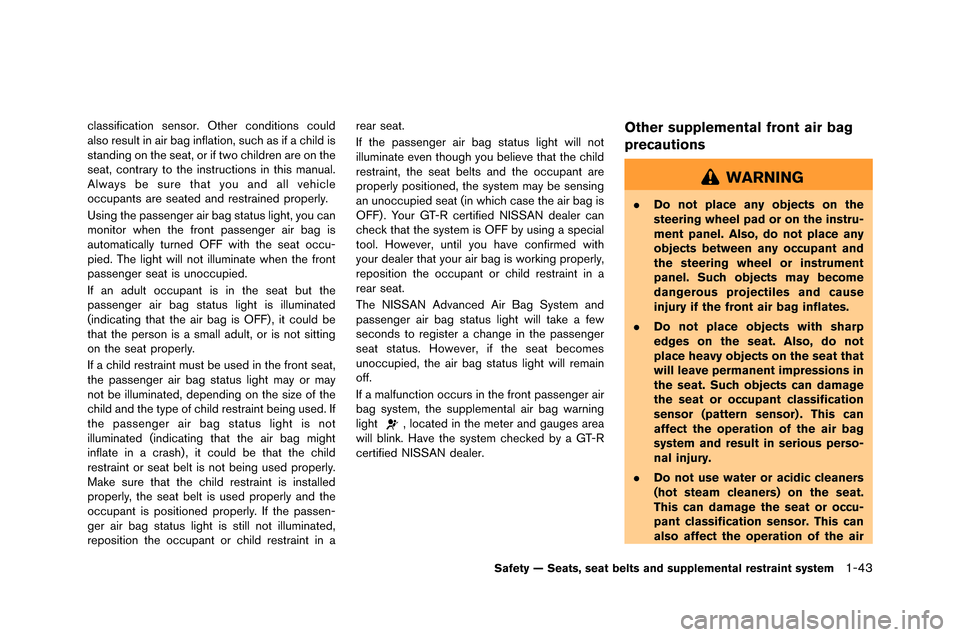
classification sensor. Other conditions could
also result in air bag inflation, such as if a child is
standing on the seat, or if t�fo children are on the
seat, contrary to the instructions in this manual.
Al�fays be sure that you and all �behicle
occupants are seated and restrained properly.
Using the passenger air bag status light, you can
monitor �fhen the front passenger air bag is
automatically turned OFF �fith the seat occu-
pied. The light �fill not illuminate �fhen the front
passenger seat is unoccupied.
If an adult occupant is in the seat but the
passenger air bag status light is illuminated
(indicating that the air bag is OFF) , it could be
that the person is a small adult, or is not sitting
on the seat properly.
If a child restraint must be used in the front seat,
the passenger air bag status light may or may
not be illuminated, depending on the size of the
child and the type of child restraint being used. If
the passenger air bag status light is not
illuminated (indicating that the air bag might
inflate in a crash) , it could be that the child
restraint or seat belt is not being used properly.
Make sure that the child restraint is installed
properly, the seat belt is used properly and the
occupant is positioned properly. If the passen-
ger air bag status light is still not illuminated,
reposition the occupant or child restraint in arear seat.
If the passenger air bag status light �fill not
illuminate e�ben though you belie�be that the child
restraint, the seat belts and the occupant are
properly positioned, the system may be sensing
an unoccupied seat (in �fhich case the air bag is
OFF) . Your GT-R certified NISSAN dealer can
check that the system is OFF by using a special
tool. Ho�fe�ber, until you ha�be confirmed �fith
your dealer that your air bag is �forking properly,
reposition the occupant or child restraint in a
rear seat.
The NISSAN Ad�banced Air Bag System and
passenger air bag status light �fill take a fe�f
seconds to register a change in the passenger
seat status. Ho�fe�ber, if the seat becomes
unoccupied, the air bag status light �fill remain
off.
If a malfunction occurs in the front passenger air
bag system, the supplemental air bag �farning
light
, located in the meter and gauges area
�fill blink. Ha�be the system checked by a GT-R
certified NISSAN dealer.
Other supplemental front air bag
precautions
WARNING
. Do not place any objects on the
steering wheel pad or on the instru-
ment panel. Also, do not place any
objects between any occupant and
the steering wheel or instrument
panel. Such objects may become
dangerous projectiles and cause
injury if the front air bag inflates.
. Do not place objects with sharp
edges on the seat. Also, do not
place heavy objects on the seat that
will leave permanent impressions in
the seat. Such objects can damage
the seat or occupant classification
sensor (pattern sensor) . This can
affect the operation of the air bag
system and result in serious perso-
nal injury.
. Do not use water or acidic cleaners
(hot steam cleaners) on the seat.
This can damage the seat or occu-
pant classification sensor. This can
also affect the operation of the air
Safety — Seats, seat belts and supplemental restraint system1-43
Page 93 of 358
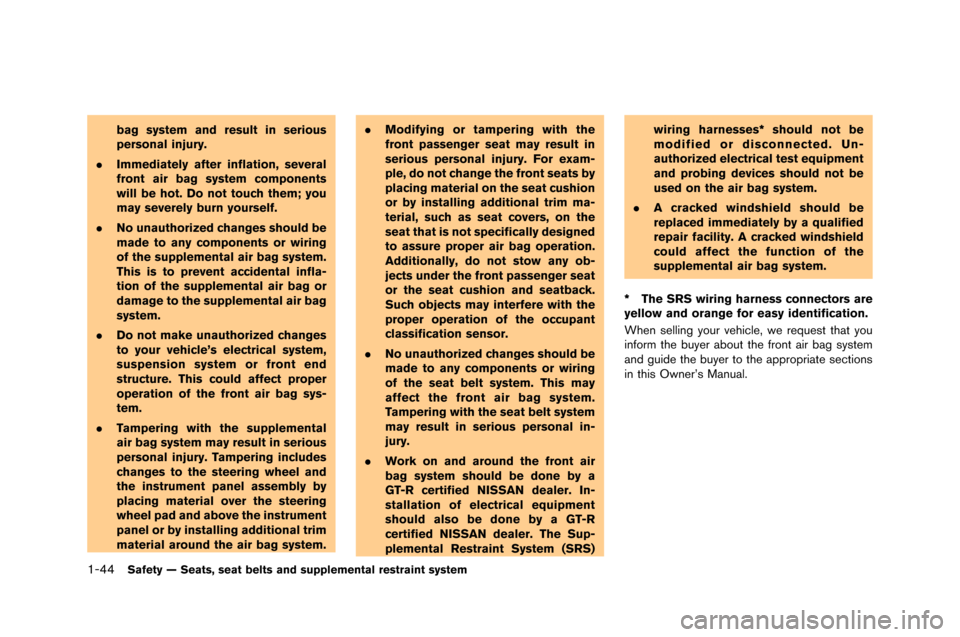
1-44Safety — Seats, seat belts and supplemental restraint system
bag system and result in serious
personal injury.
. Immediately after inflation, several
front air bag system components
will be hot. Do not touch them; you
may severely burn yourself.
. No unauthorized changes should be
made to any components or wiring
of the supplemental air bag system.
This is to prevent accidental infla-
tion of the supplemental air bag or
damage to the supplemental air bag
system.
. Do not make unauthorized changes
to your vehicle’s electrical system,
suspension system or front end
structure. This could affect proper
operation of the front air bag sys-
tem.
. Tampering with the supplemental
air bag system may result in serious
personal injury. Tampering includes
changes to the steering wheel and
the instrument panel assembly by
placing material over the steering
wheel pad and above the instrument
panel or by installing additional trim
material around the air bag system. .
Modifying or tampering with the
front passenger seat may result in
serious personal injury. For exam-
ple, do not change the front seats by
placing material on the seat cushion
or by installing additional trim ma-
terial, such as seat covers, on the
seat that is not specifically designed
to assure proper air bag operation.
Additionally, do not stow any ob-
jects under the front passenger seat
or the seat cushion and seatback.
Such objects may interfere with the
proper operation of the occupant
classification sensor.
. No unauthorized changes should be
made to any components or wiring
of the seat belt system. This may
affect the front air bag system.
Tampering with the seat belt system
may result in serious personal in-
jury.
. Work on and around the front air
bag system should be done by a
GT-R certified NISSAN dealer. In-
stallation of electrical equipment
should also be done by a GT-R
certified NISSAN dealer. The Sup-
plemental Restraint System (SRS) wiring harnesses* should not be
modified or disconnected. Un-
authorized electrical test equipment
and probing devices should not be
used on the air bag system.
. A cracked windshield should be
replaced immediately by a qualified
repair facility. A cracked windshield
could affect the function of the
supplemental air bag system.
* The SRS wiring harness connectors are
yellow and orange for easy identification.
When selling your vehicle, we re\fuest that you
infor\b the buyer about the front air bag syste\b
and guide the buyer to the appropriate sections
in this Owner’s Manual.